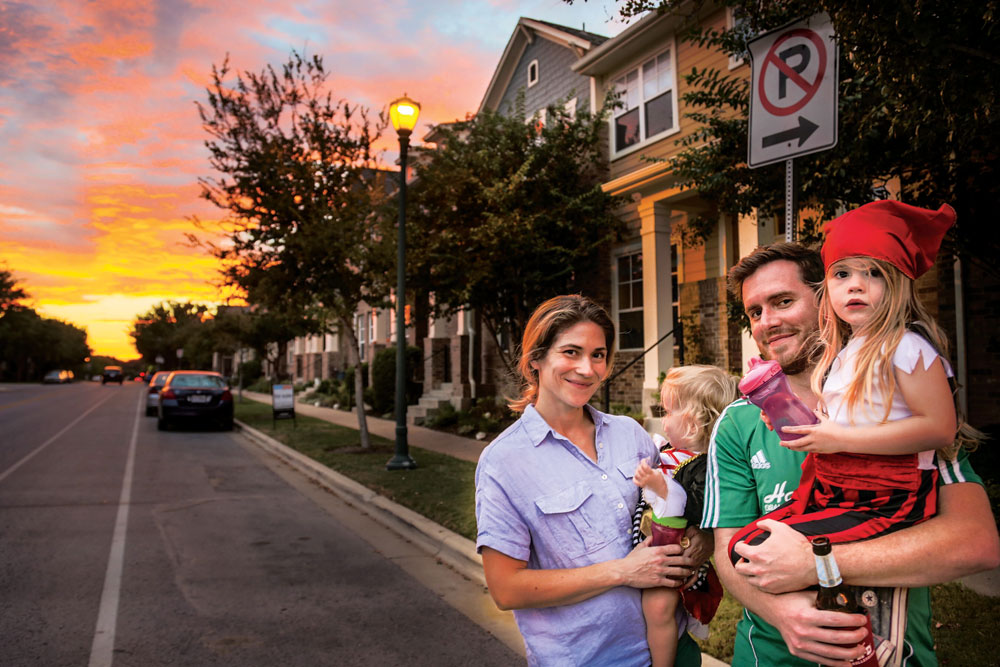
The Hill family, Susanna holding Margot, 11/2, and Hutch holding Beatrix, 3, joined other neighbors in Mueller Austin to see the perfect Texas sunset. Mueller, a new planned community on the site of Austin’s decommissioned airport, has many similarities to Stapleton.
A Stapleton neighbor who visited the Mueller (pronounced “Miller”) neighborhood in Austin, Texas, said it seemed just like being in Stapleton and suggested we visit to see for ourselves. Mueller is being built on a 700-acre decommissioned municipal airport that is three miles east of downtown Austin, two miles from the University of Texas. Mueller and Stapleton are being developed concurrently—and both are touted as highly successful infill developments. Are they twins? We were intrigued—and spent a long weekend there to find out.
Mueller from Anne Hebert on Vimeo.
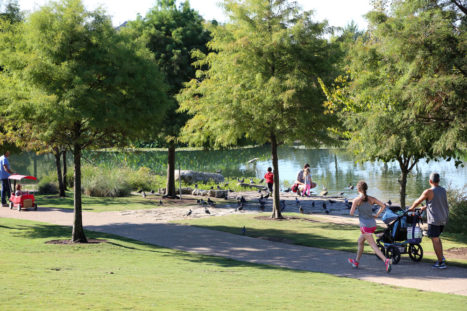
As in Stapleton, parks serve storm drainage, flood control, and water quality purposes.
When we arrived, we found families wandering among vendors in an old hangar and visiting food trucks in the park. It was the opening event for the police department’s National Night Out. The next morning, a Sunday, was the farmers market. Both felt a lot like Stapleton events.
The People
Mueller residents have a lot in common with the people of Stapleton. They love living near friendly neighbors they know, they appreciate the family-friendly activities in the neighborhood, the parks and open space, and the proximity to downtown. Erika Garcia and her husband, both school teachers in Austin, were the fourth family to move in at Mueller. “We loved the location,” and, she says, that made up for all the uncertainties of being an early buyer. They live in a “yard home,” Mueller’s name for single-family homes. After 10 years, Garcia says, the only downside is the small yard—and it’s outweighed by all the rest.

Outdoor recreation is enjoyed by Mueller residents.
At the farmers market we asked Anita Putman, an African-American woman, about race and diversity in Mueller. “The good thing about Mueller is it has a mixture of cultures. You might not see a lot of African Americans here. But it doesn’t matter. Everyone just joins in and has a big party—I think what holds it together is the dogs and the families.” Putman’s friends Jeff and Chrissy Yates, an interracial couple who moved a year ago from Ann Arbor, joined the conversation. They had heard about Mueller on NPR and rented their apartment sight unseen based on the description of a truly integrated community. They describe their apartment complex as diverse in gender, race and age. Under Mueller’s affordable housing program, a minimum of 15 percent of the units in every apartment building are affordable, adding income diversity to the mix.
Jill Fagan, a project manager for the City of Austin, lived and worked as a planner in Denver from 2005 to 2006 (and lived in Stapleton for part of that time). She cites many commonalities between the two communities: “I think the design elements work—tree-lined streets, sidewalks, gathering places, parks, greenways, front porches … and the fact that everybody knows each other. I think they are people of that self-selecting group who want more of that social and community interaction.”
To create this type of community, “You have to have forward thinking people. Just like at Stapleton they had to believe in the dream and the napkin sketch when they signed up to buy a house,” says Dee Desjardin, VP for marketing and communications with Catellus (the master developer), “…others come along later because now they can see it and their friend is here and they love it.”
Homes and Commercial at Mueller
The residential streets feel like we could be in Stapleton, with a combination of townhomes, garden court homes, and the single-family “yard” homes. But Mueller is significantly denser than Stapleton. Based on the 700-acre size and projected population of 13,000, Mueller will have a density of 18.5 people per acre. Stapleton’s land area is six times larger. Based on 4,100 acres and a projected population of 30,000, Stapleton will have a density of 7.3 people per acre (or 9.75 if the population reaches 40,000).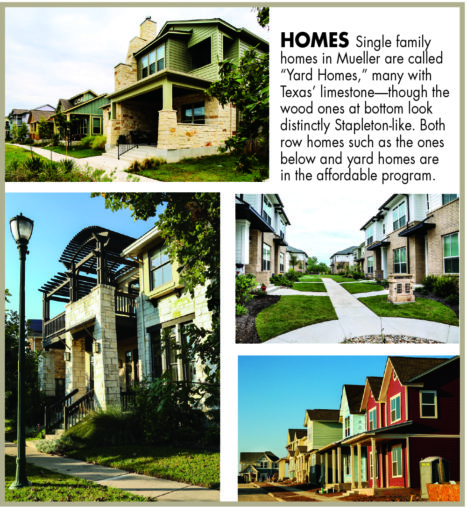
Despite some early concerns about density, Mueller residents are becoming aware of the benefits that come with density. “The neighborhood association at Mueller has asked for additional density. The city is saying you can’t really do it. They have maxed out what we can do with the transportation modifications,” says Rick Krivoniak, an architect, who has participated in the vision and oversight of the Mueller plan since the 80s. Krivoniak, Girard Kinney and Jim Walker (quoted later), all live in neighborhoods near Mueller and all have been active for many years guiding the Mueller vision, and they have served on the Plan Implementation Advisory Committee (PIAC) that reports to city council on the progress of Mueller development.
The main difference in the aesthetic of Mueller homes is the Texas limestone. Lots of it. Jim Adams, who wrote the Mueller Development Plan, remembers being impressed when he arrived from California. “It’s stone. It’s incredible.” Now he admits he’s lost some of that appreciation because it’s so plentiful.
Mueller has a community retail area with shops, restaurants, a bank, and a grocery store. A big box retail shopping area is separate from the residential areas and close to the nearby interstate highway. The neighbors who participated for years in the planning were disappointed they ended up with big box retail rather than the tech center they had envisioned during Austin’s tech boom. But, as with Stapleton, the big box retail brought tax revenue that was critical in the early years of the development. Mueller’s town center is not yet built and will be “evolving organically,” according to Greg Weaver, executive vice president of Catellus. Waiting to build the town center will allow for greater density and more locally owned businesses than would have been possible if it had been built at the beginning.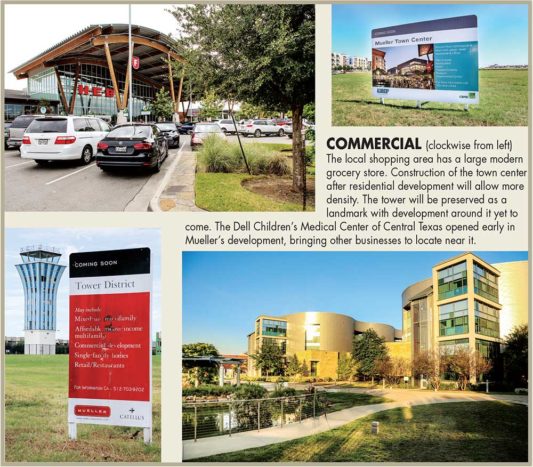
Parks
Twenty percent of Mueller’s land is parks and open space (140 acres), most of which is located on the perimeter of the neighborhood. The project invested in having the big main park built early, creating a shared amenity between the older surrounding neighborhoods and the new homes. As in Stapleton, the parks also serve storm drainage, flood control, and water quality purposes. Stapleton has 25% park and open space land, and at 1,250 acres has almost ten times more park land than Mueller.
What Mueller Learned from Stapleton
Weaver says, “Stapleton did well because they did a great master plan. They committed to design guidelines, the Green Book, all those things.” Mueller started a few years after Stapleton—and the Austin team looked to refine their plans based on lessons learned at Stapleton, along with other infill developments around the country.
Build an economic driver: Mueller developers and city staff visited Stapleton in 2002 and followed Stapleton’s lead in creating an economic driver similar to Quebec Square at the beginning. With that as a given, says Weaver, they then asked the question “how do you make these big box centers where they are economic drivers early on, but then look long-term to redevelopment?” He explains that what now looks like two big blocks of parking lots has the infrastructure to become eight blocks of mixed-use development with sidewalks, streetlights and utilities in the future.
Make zoning flexible: Austin project manager Fagan says Stapleton taught Mueller the lesson that they need flexibility in their zoning. When the market changes and the zoning is hard wired, that “makes it more difficult to implement changes in the plan.”
Mueller has planned unit development (PUD) zoning, a framework with flexibility without going to city council for every change, says Fagan. “The PUD has a limit to total square footage for retail, residential, vehicular trips, but we have the ability to modify on a lot by lot basis.” Another example: the ratio of rental to for-sale units can be anywhere from 40/60 to 60/40.

Affordable housing program: The Mueller team says Stapleton gave them the idea of creating a foundation to support affordable housing and having a homebuyer education program. They also realized, after seeing Stapleton’s program, the need to consider routine living costs, like the expense of a car or schooling, in the affordability model. Mueller may have found some ideas for their affordable program in Stapleton, but it is being implemented quite differently.
Forest City’s affordable housing contract with Denver requires that they set aside land for affordable housing but does not compel construction of the homes. Keeping pace with market rate construction is a goal but not an enforceable requirement.
Catellus’ contract with the city of Austin requires that, at completion of the project, 25% of homes will have been built consistent with the affordable homes requirement. They are built in each phase along with the market rate homes, the proportion varying slightly from one phase to the next. Early on, Catellus held an affordable summit to develop a plan. The takeaway, says Weaver, was to “make the market rate home builders do affordable housing. That way they have the opportunity for profit on the market rate homes which balances the requirement to build affordable housing, all with the same quality.”
Weaver recalls getting a call from David Weekley Homes saying they had initially turned down the opportunity to build at Stapleton (which they considered a big mistake), and they wanted to be a builder at Mueller. Weaver informed them about the affordable requirement, which initially caused some concern. But, “They love it now … they promote it in their newsletters. They got in the trenches with us to really work through … how the program could be worked out,” says Weaver.
Mueller has its own self-contained affordable housing program, in which the foundation has hired a third party administrator that works with the homebuilders to efficiently take Mueller buyers from the qualifying process through mortgage approval. The Mueller Foundation holds a “soft second lien” on the home. The buyers get a 2% annual increase in value, and the Mueller Foundation has the first right of refusal to purchase the property back and keep it in the program. Every property sale in Mueller, commercial and residential, includes a quarter percent fee that goes to the Foundation. That fund covers costs inherent in the homes’ resale, including repairs and updating, as well as other community enhancement efforts.
Since the program is working well and the need for affordable housing in the region is so great, Catellus is now contracting with builders to add 10% of future homes for buyers in the 80-120% of median family income (MFI) range. “It’s not required in the development agreement, Catellus is choosing to do it,” points out Jim Walker.

Jessica Neyman plays chase with son Lucas, 5, in the community garden. She says parents are concerned about where their young children will go to school.
The affordable homes are interspersed among the market rate homes and are virtually indistinguishable from them. There are no exclusively affordable home types or groupings in Mueller. In Stapleton, Thrive is the only builder that has taken the approach of interspersing affordable units with their market rate ones.
Structure of the development agreement: Development plan author Jim Adams says the master development agreement negotiated between the city of Austin and Catellus was informed by the deal at Stapleton and other public-private projects going on at the time. The City of Austin viewed the Mueller development as an opportunity to not only get parks, affordable housing and add to the tax rolls, but they also wanted to share in profits if the project was a success. According to the development agreement, Catellus makes 15% on the land sales. At the end of the project any upside goes to the city. Catellus VP Weaver says, “the City, which is ultimately the taxpayers, gets the benefit.”
In Denver, the taxpayers and the City of Denver did not want to spend taxpayer money on the redevelopment of the old airport. The perception at the time was that the land didn’t have much value. Mayor Webb told the Front Porch in September 2015, “My priority was always DIA.” Redevelopment of Stapleton, he said, was just one of many other big projects on his list at that time. His biggest concern at Stapleton was negotiating for 25% parkland, which he achieved.
A 2011 report by the FAA states the Stapleton land was sold without the option to take advantage of any potential increases in real estate prices and it was based on a 1999 appraisal that significantly underestimated Stapleton land appreciation.* A higher price for the Stapleton land would have sent more proceeds to DIA, but not directly to the city of Denver.
When the Mueller contract was negotiated, the development climate in Austin, as described by Jim Walker, sounds distinctly different from the circumstances surrounding the Stapleton negotiations. “One of the big mantras back in the late 90s was: development should pay for itself. Go into a public meeting and have a developer say 15% isn’t good enough… That’s just not going to play well in a political climate where developers are looking like they are trying to take everything.”
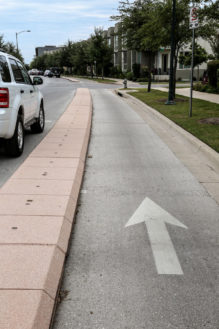
The original bike lanes are being retrofitted as cycle tracks, which provide more protection for bicyclists.
Former chair of the Stapleton Citizens Advisory Board David Netz says, “During the great recession, Forest City financed much of the redevelopment and made its own investments in the community, but given current property values the terms are essentially a license to print money.”
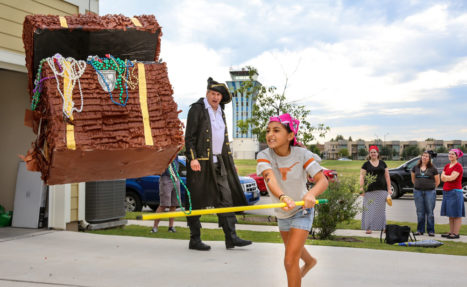
With small yards, families gather in the alley, as for this pirate birthday party.
Differences between Stapleton and Mueller
Schools: The Mueller team was very interested to hear schools were included in Stapleton’s TIF and wished that a specific commitment for a school had been made for Mueller, though land is set aside. Students attend the surrounding schools. Parents told us many families are choosing charter schools because they are unhappy with the performance of the neighborhood schools. Girard Kinney, points out that a new elementary school with only Mueller students would “enforce the kind of gated image of this place.” He would like to see a middle school that brings in students from surrounding neighborhoods—an idea similar to the Stapleton-Park Hill shared boundaries for middle school.
Special district tax: Mueller has no special district tax; the TIF revenue and land sales pay for all infrastructure development. In contrast, Stapleton’s TIF pays for just the major infrastructure and a special district tax on residents pays for the local infrastructure, making their bill 72 percent higher than the rest of Denver’s (Denver city/school tax is 78 mills. Stapleton’s metro district adds 56.6 mills.) However, a comparison of Colorado and Texas taxes is not “apples to apples,” says Fagan, because Texas has no state income tax and has higher property and school taxes.
How do the developer, the city and the neighborhood activists resolve conflicts?
“Let me say, when we’ve had disagreements. Greg (Weaver) has just been fantastic in that he’s willing to talk. He will talk to anybody who wants to discuss an issue—and so we’ve always been able to pretty much work it out,” says Kinney.
Weaver adds, “We do surveys asking questions all the time about what people want, what they don’t want. I think it’s our philosophy if there’s a way we could do things, we will try to address it.”

An old hanger by Mueller’s big lake park is the site for community activities including a farmers market.
“It’s a continual community dialogue,” says Adams. “The plan made in 2000 had bike lanes all over the place, but around 2005-2006 the best practice was protected bike lanes. Greg called me up one day and said, ‘Why aren’t we doing cycle tracks?’ …so we are now retrofitting streets that were built in 2005 to include cycle tracks.”
And if all else fails, go out for drinks. Weaver describes the time Rick (Krivoniak) tried to convince him to change the location targeted for a bank to become what is now the popular local restaurant Torchy’s. “One day we went out for drinks and I said, ‘You’re right, that is the dumbest idea. Why are we putting a bank there?’ So we just started drawing. I give Rick a lot of credit that he pulled me aside and suggested a change that turned out to be a great decision.”
*FAA Did Not Ensure Revenue Was Maximized at Denver International Airport.
Federal Aviation Administration, Report Number: AV-2011-057, February 28, 2011.



0 Comments